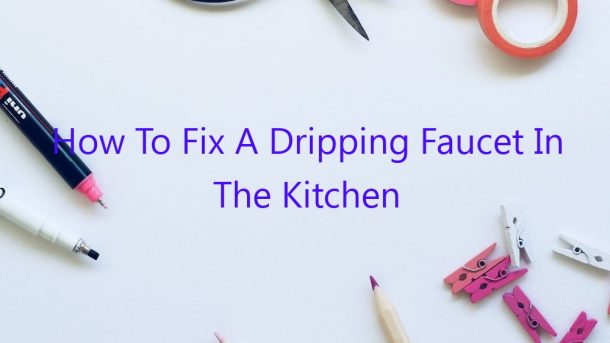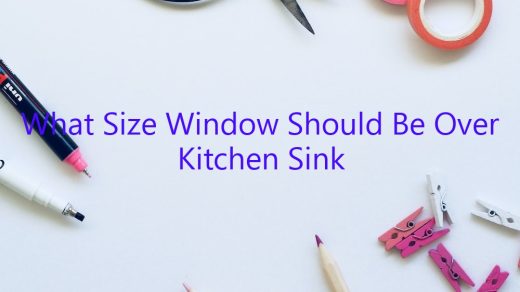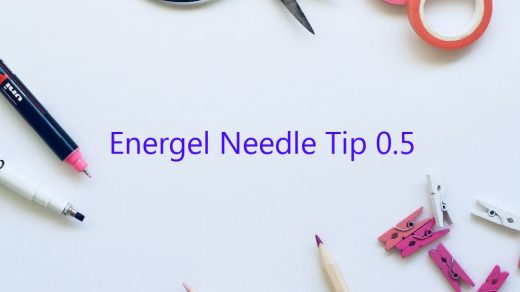Is your kitchen faucet dripping? This common plumbing problem can be fixed with a few simple steps.
The first step is to identify the source of the leak. Turn off the water supply to the faucet and inspect the fixture for signs of damage. If the faucet is dripping from the handle, the washer may need to be replaced. If the faucet is dripping from the spout, the valve may need to be tightened.
Once you’ve identified the source of the leak, you can start repairing it. If the faucet is dripping from the handle, replace the washer by unscrewing the handle and removing the old washer. Insert the new washer and screw the handle back in place. If the faucet is dripping from the spout, tighten the valve by turning the handle clockwise.
If the faucet is still dripping after you’ve replaced the washer or tightened the valve, you may need to call a plumber.
Contents
How do I stop my kitchen faucet from dripping?
If you’ve ever lived in a house with a kitchen faucet that drips, you know the annoyance it can cause. Not only is the sound of the dripping water annoying, but it can also lead to wasted water and higher water bills. Fortunately, there are a few ways to stop a kitchen faucet from dripping, and we’ll explore them in this article.
One way to stop a kitchen faucet from dripping is to replace the washer. The washer is the part of the faucet that wears out over time and causes the faucet to drip. To replace the washer, you’ll need to remove the faucet handle and the valve stem. Once the handle and valve stem are removed, you can replace the washer.
Another way to stop a kitchen faucet from dripping is to adjust the packing nut. The packing nut is the part of the faucet that adjusts the watertightness of the faucet. You can adjust the packing nut by turning it with a wrench.
Finally, if neither of these methods work, you may need to replace the faucet. Replacing a kitchen faucet can be a bit tricky, so if you’re not comfortable doing it yourself, you may want to call a plumber.
Hopefully, one of these methods will stop your kitchen faucet from dripping. If not, you may need to replace the faucet altogether.
Why is my kitchen faucet dripping water?
Kitchen faucets are one of the most commonly used pieces of plumbing in any home. They are also one of the most prone to problems. One common problem with kitchen faucets is that they can start to drip water. This can be a nuisance and can also lead to water wastage.
There are a few reasons why your kitchen faucet might be dripping water. One of the most common reasons is that the faucet is old and needs to be replaced. Another reason might be that the seals of the faucet are worn and need to be replaced. If the faucet is dripping because of a clog, you might be able to fix the problem by using a plunger.
If your kitchen faucet is dripping water, the best thing to do is to try to determine the cause of the problem. If the faucet is old and needs to be replaced, you might want to consider doing so. If the seals of the faucet are worn, you can replace them yourself. If the faucet is dripping because of a clog, you can try to fix the problem by using a plunger. If none of these solutions work, you might need to call a plumber to fix the problem for you.
Why does my faucet drip after I turn it off?
The sound of a dripping faucet is one that is often heard in households across the world. Though it can be annoying, it is usually a simple fix. So, why does my faucet drip after I turn it off?
There are a few reasons why a faucet might start dripping after being turned off. One common reason is that the faucet was not turned off completely, and a small amount of water is still flowing out. This can be fixed by turning the faucet off completely and then turning it back on.
Another reason a faucet might drip after being turned off is a faulty valve. If the valve is not closing properly, it can allow water to flow out even after the faucet has been turned off. This can be fixed by replacing the valve.
If neither of these reasons are the cause of the dripping faucet, it might be that the faucet needs to be tightened. Over time, the faucet can become loose and start to drip. This can be fixed by tightening the faucet’s screws or by using a wrench to tighten the valve.
So, why does my faucet drip after I turn it off? There are a few possible reasons, but most of them can be fixed relatively easily.
What is the most common cause of a dripping faucet?
A dripping faucet is a common household problem that can be caused by a variety of issues. In this article, we will discuss the most common cause of a dripping faucet.
The most common cause of a dripping faucet is a worn-out valve seat. The valve seat is the part of the faucet that the valve stem rests on. When the valve seat wears out, it can cause the valve stem to move too easily, which will cause the faucet to drip.
If your faucet is dripping, the best thing to do is to call a plumber to fix it. A plumber will be able to determine the cause of the dripping and will be able to fix it.
How do you fix a dripping kitchen faucet with two handles?
If your kitchen faucet is dripping, it can be annoying and wasteful. Fortunately, it is usually a simple fix. This guide will show you how to fix a dripping kitchen faucet with two handles.
The first step is to identify the type of faucet you have. There are two types of faucets- compression and cartridge. Compression faucets have a washer that needs to be replaced, while cartridge faucets have a cartridge that needs to be replaced.
If you have a compression faucet, the next step is to determine if the washer is worn out. To do this, turn off the water and remove the handle. There should be a screw on the side of the faucet that you can remove to reveal the washer. If the washer is worn out, you will need to replace it.
If you have a cartridge faucet, the next step is to determine if the cartridge is worn out. To do this, turn off the water and remove the handle. There should be a screw on the side of the faucet that you can remove to reveal the cartridge. If the cartridge is worn out, you will need to replace it.
If you have a dripping kitchen faucet with two handles, it is most likely a compression faucet. To fix it, you will need to replace the washer.
Does my kitchen faucet have a cartridge?
A kitchen faucet cartridge is a small, cylindrical piece of plastic or metal that sits in the neck of a kitchen sink faucet. It is the part of the faucet that the water flows through. Most kitchen faucet cartridges are made of plastic, and they have a rubber seal on one end that seals against the faucet body. The other end has a number of slots or holes in it that the water flows through.
Kitchen faucet cartridges are replaceable, and they are usually replaced when the faucet starts to leak. They can also be replaced if the faucet starts to drip or if the water flow is weak. To replace a kitchen faucet cartridge, first turn off the water to the faucet. Then, unscrew the cartridge from the faucet body. Be careful not to lose the rubber seal. Install the new cartridge, and screw it into the faucet body. Turn on the water and check for leaks.
Is it bad if a faucet drips?
Is it bad if a faucet drips?
The answer to this question is: it depends. A dripping faucet can be annoying and can waste water, but it’s not usually a problem unless it’s dripping a lot of water.
If your faucet is dripping a lot of water, you may want to have it repaired. A dripping faucet can waste a lot of water over time, and it can also increase your water bill.
If your faucet is dripping only a little bit of water, it’s usually not a big deal. You can just let it run until it stops dripping. However, you may want to have it repaired if it’s dripping a lot of water, since it can waste a lot of water over time.




